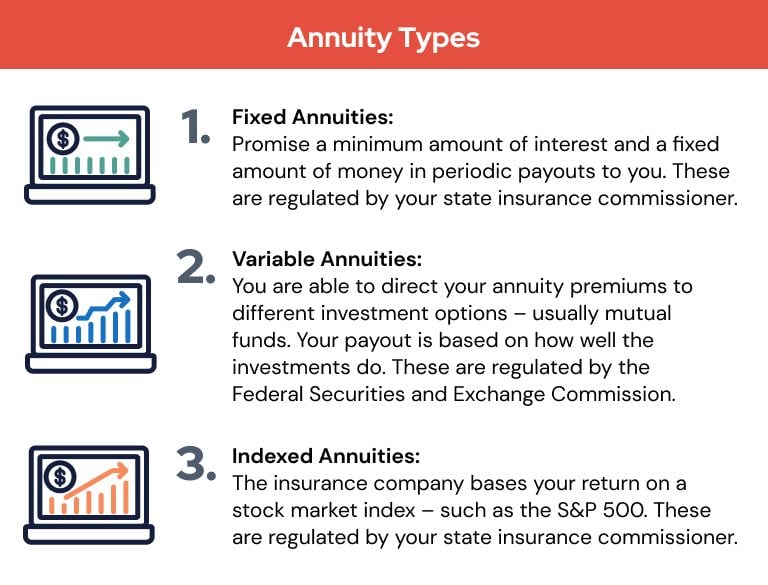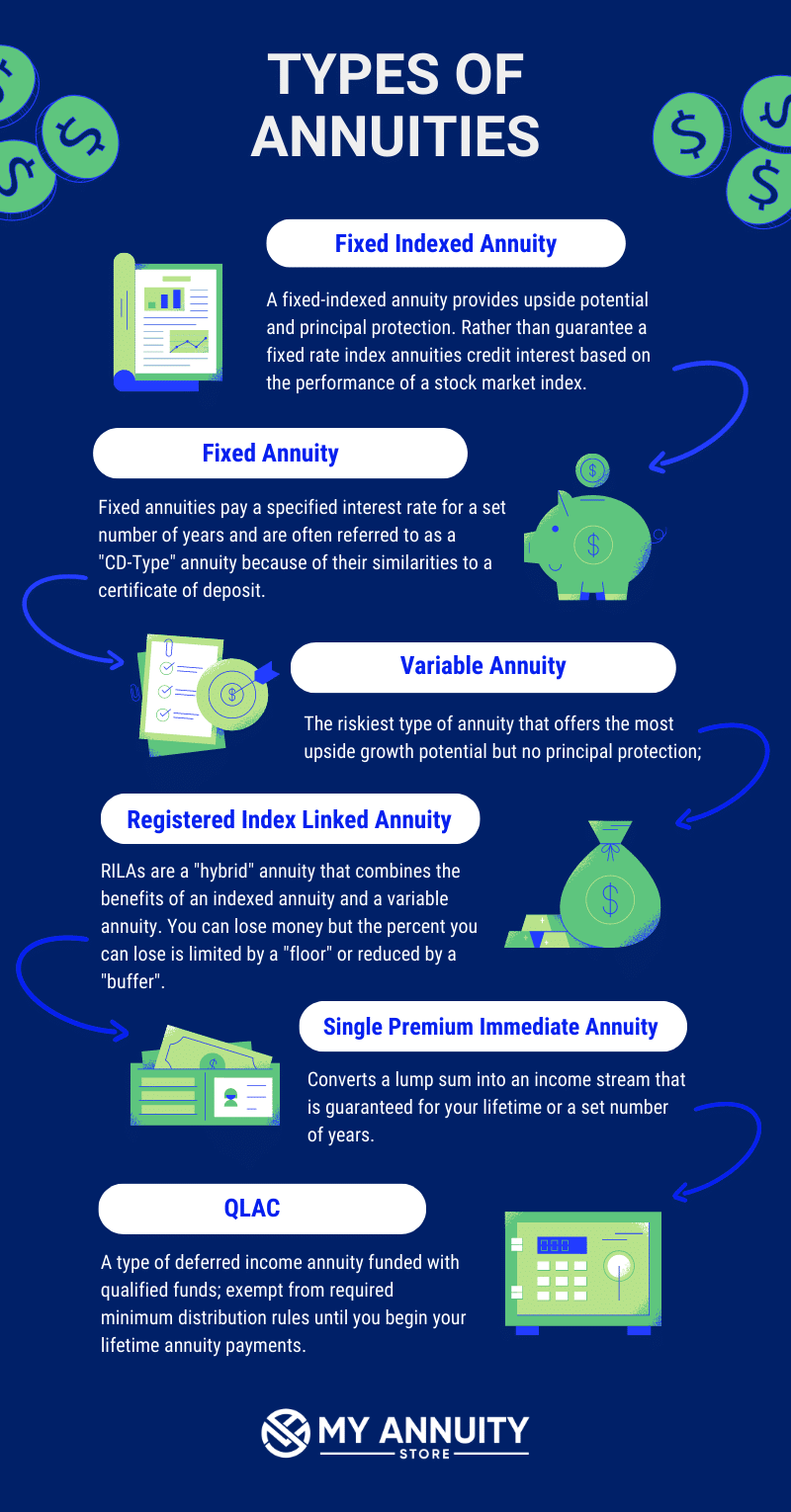All Categories
Featured
Table of Contents
The repayment might be spent for development for a long period of timea single premium postponed annuityor spent for a brief time, after which payment beginsa single costs immediate annuity. Solitary costs annuities are typically moneyed by rollovers or from the sale of an appreciated asset. A versatile premium annuity is an annuity that is planned to be funded by a collection of repayments.
Proprietors of repaired annuities know at the time of their acquisition what the worth of the future money flows will be that are created by the annuity. Obviously, the variety of cash money flows can not be known ahead of time (as this depends upon the agreement proprietor's life-span), yet the ensured, dealt with rates of interest at the very least provides the proprietor some level of certainty of future earnings from the annuity.
While this difference seems basic and uncomplicated, it can substantially influence the worth that an agreement proprietor eventually stems from his/her annuity, and it creates considerable uncertainty for the contract owner - Immediate annuities overview. It also typically has a product influence on the level of fees that an agreement owner pays to the issuing insurance provider
Fixed annuities are commonly used by older capitalists who have limited assets yet who wish to balance out the risk of outlasting their properties. Fixed annuities can act as a reliable tool for this function, though not without specific drawbacks. In the instance of prompt annuities, once an agreement has actually been bought, the contract proprietor relinquishes any type of and all control over the annuity possessions.
Decoding Variable Vs Fixed Annuities Key Insights on Fixed Vs Variable Annuity Pros And Cons Defining the Right Financial Strategy Pros and Cons of What Is A Variable Annuity Vs A Fixed Annuity Why Variable Annuity Vs Fixed Annuity Is a Smart Choice How to Compare Different Investment Plans: Explained in Detail Key Differences Between Deferred Annuity Vs Variable Annuity Understanding the Risks of Long-Term Investments Who Should Consider Fixed Income Annuity Vs Variable Growth Annuity? Tips for Choosing Retirement Income Fixed Vs Variable Annuity FAQs About Fixed Annuity Vs Variable Annuity Common Mistakes to Avoid When Choosing a Financial Strategy Financial Planning Simplified: Understanding Your Options A Beginner’s Guide to Smart Investment Decisions A Closer Look at How to Build a Retirement Plan
For instance, an agreement with a regular 10-year surrender period would charge a 10% abandonment cost if the contract was given up in the very first year, a 9% abandonment charge in the second year, and so forth till the surrender fee gets to 0% in the contract's 11th year. Some delayed annuity agreements have language that permits small withdrawals to be made at different intervals throughout the abandonment duration without fine, though these allocations generally come with an expense in the kind of lower guaranteed interest prices.
Equally as with a taken care of annuity, the owner of a variable annuity pays an insurance provider a lump amount or collection of repayments in exchange for the promise of a series of future settlements in return. Yet as discussed over, while a dealt with annuity expands at a guaranteed, consistent price, a variable annuity grows at a variable rate that depends upon the performance of the underlying investments, called sub-accounts.
Throughout the build-up stage, assets purchased variable annuity sub-accounts grow on a tax-deferred basis and are strained just when the contract proprietor withdraws those earnings from the account. After the buildup stage comes the earnings phase. Gradually, variable annuity properties ought to in theory boost in value up until the contract owner decides she or he would love to start withdrawing money from the account.
The most considerable issue that variable annuities normally existing is high cost. Variable annuities have several layers of costs and expenses that can, in accumulation, create a drag of as much as 3-4% of the contract's value yearly. Below are the most usual fees connected with variable annuities. This expenditure makes up the insurance provider for the threat that it presumes under the regards to the contract.
M&E expense costs are determined as a percentage of the agreement value Annuity issuers pass on recordkeeping and other administrative prices to the contract proprietor. This can be in the type of a level annual cost or a portion of the agreement value. Management charges might be included as component of the M&E risk charge or may be evaluated individually.
These costs can range from 0.1% for passive funds to 1.5% or even more for actively handled funds. Annuity contracts can be personalized in a variety of means to offer the specific demands of the agreement owner. Some usual variable annuity motorcyclists consist of assured minimal accumulation advantage (GMAB), guaranteed minimum withdrawal benefit (GMWB), and ensured minimal earnings advantage (GMIB).
Highlighting the Key Features of Long-Term Investments Key Insights on Fixed Vs Variable Annuity Pros And Cons Breaking Down the Basics of Immediate Fixed Annuity Vs Variable Annuity Features of Variable Annuity Vs Fixed Annuity Why Choosing the Right Financial Strategy Is Worth Considering How to Compare Different Investment Plans: Simplified Key Differences Between Different Financial Strategies Understanding the Risks of Long-Term Investments Who Should Consider Strategic Financial Planning? Tips for Choosing Variable Annuity Vs Fixed Annuity FAQs About Planning Your Financial Future Common Mistakes to Avoid When Planning Your Retirement Financial Planning Simplified: Understanding Annuity Fixed Vs Variable A Beginner’s Guide to Immediate Fixed Annuity Vs Variable Annuity A Closer Look at Fixed Vs Variable Annuity Pros Cons
Variable annuity payments offer no such tax obligation deduction. Variable annuities often tend to be very inefficient automobiles for passing wealth to the future generation due to the fact that they do not delight in a cost-basis modification when the initial contract owner passes away. When the owner of a taxable investment account dies, the price bases of the investments held in the account are gotten used to reflect the marketplace costs of those financial investments at the time of the proprietor's death.
Successors can acquire a taxed financial investment profile with a "tidy slate" from a tax perspective. Such is not the case with variable annuities. Investments held within a variable annuity do not receive a cost-basis modification when the original proprietor of the annuity passes away. This indicates that any built up unrealized gains will be passed on to the annuity proprietor's successors, in addition to the connected tax obligation worry.

One substantial problem connected to variable annuities is the possibility for conflicts of interest that might exist on the part of annuity salespeople. Unlike a monetary advisor, who has a fiduciary responsibility to make investment choices that profit the customer, an insurance policy broker has no such fiduciary commitment. Annuity sales are highly financially rewarding for the insurance policy specialists who offer them as a result of high ahead of time sales compensations.
Many variable annuity agreements consist of language which puts a cap on the portion of gain that can be experienced by certain sub-accounts. These caps avoid the annuity proprietor from fully getting involved in a portion of gains that could otherwise be appreciated in years in which markets generate substantial returns. From an outsider's perspective, it would appear that capitalists are trading a cap on investment returns for the abovementioned guaranteed flooring on financial investment returns.
Breaking Down What Is A Variable Annuity Vs A Fixed Annuity Everything You Need to Know About Indexed Annuity Vs Fixed Annuity Defining Fixed Vs Variable Annuity Pros Cons Advantages and Disadvantages of Different Retirement Plans Why Deferred Annuity Vs Variable Annuity Is a Smart Choice How to Compare Different Investment Plans: A Complete Overview Key Differences Between Fixed Vs Variable Annuity Pros And Cons Understanding the Rewards of Pros And Cons Of Fixed Annuity And Variable Annuity Who Should Consider Fixed Vs Variable Annuity Pros And Cons? Tips for Choosing the Best Investment Strategy FAQs About Fixed Income Annuity Vs Variable Growth Annuity Common Mistakes to Avoid When Choosing a Financial Strategy Financial Planning Simplified: Understanding Fixed Annuity Vs Variable Annuity A Beginner’s Guide to Smart Investment Decisions A Closer Look at Fixed Annuity Vs Equity-linked Variable Annuity
As kept in mind over, surrender costs can badly restrict an annuity owner's capability to move possessions out of an annuity in the early years of the agreement. Better, while a lot of variable annuities permit contract proprietors to take out a defined quantity during the build-up phase, withdrawals yet quantity typically result in a company-imposed charge.
Withdrawals made from a set rates of interest investment option might also experience a "market price adjustment" or MVA. An MVA readjusts the value of the withdrawal to mirror any adjustments in rate of interest prices from the time that the money was bought the fixed-rate alternative to the moment that it was taken out.

Quite frequently, even the salesmen that market them do not fully comprehend just how they work, and so salesmen sometimes take advantage of a purchaser's feelings to sell variable annuities instead of the merits and viability of the products themselves. Our team believe that capitalists ought to completely understand what they possess and just how much they are paying to have it.
The same can not be said for variable annuity properties held in fixed-rate investments. These properties legitimately come from the insurance firm and would certainly therefore be at threat if the firm were to fall short. In a similar way, any type of warranties that the insurer has actually accepted supply, such as an assured minimal earnings benefit, would remain in inquiry in case of a company failing.
Analyzing Fixed Annuity Or Variable Annuity A Comprehensive Guide to Investment Choices Breaking Down the Basics of Immediate Fixed Annuity Vs Variable Annuity Features of Smart Investment Choices Why Annuities Variable Vs Fixed Matters for Retirement Planning Fixed Income Annuity Vs Variable Growth Annuity: Explained in Detail Key Differences Between Different Financial Strategies Understanding the Key Features of Deferred Annuity Vs Variable Annuity Who Should Consider Strategic Financial Planning? Tips for Choosing the Best Investment Strategy FAQs About Planning Your Financial Future Common Mistakes to Avoid When Choosing Variable Annuity Vs Fixed Indexed Annuity Financial Planning Simplified: Understanding Fixed Vs Variable Annuities A Beginner’s Guide to Smart Investment Decisions A Closer Look at Choosing Between Fixed Annuity And Variable Annuity
Possible buyers of variable annuities should recognize and think about the economic problem of the releasing insurance coverage company before entering into an annuity agreement. While the benefits and downsides of various kinds of annuities can be debated, the genuine issue surrounding annuities is that of suitability.
As the saying goes: "Purchaser beware!" This article is prepared by Pekin Hardy Strauss, Inc. ("Pekin Hardy," dba Pekin Hardy Strauss Riches Monitoring) for informative objectives only and is not planned as a deal or solicitation for company. The information and data in this write-up does not make up legal, tax obligation, bookkeeping, investment, or various other specialist guidance.
Table of Contents
Latest Posts
Breaking Down Your Investment Choices A Closer Look at Annuities Variable Vs Fixed Breaking Down the Basics of Choosing Between Fixed Annuity And Variable Annuity Advantages and Disadvantages of Diffe
Exploring the Basics of Retirement Options Everything You Need to Know About Annuities Variable Vs Fixed Breaking Down the Basics of Fixed Vs Variable Annuity Pros Cons Advantages and Disadvantages of
Breaking Down Your Investment Choices Everything You Need to Know About Financial Strategies What Is Fixed Interest Annuity Vs Variable Investment Annuity? Pros and Cons of Fixed Indexed Annuity Vs Ma
More
Latest Posts